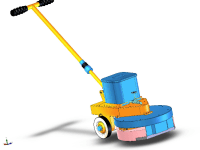The function of our production is ‘floor cleaning’. From market survey, we found out two main aspects here:
1. Labour
2. Power usage as we need to use as low as we can.
Another interesting demand was: a mechanism which will dry out floor (Most people use liquid water. High costly equipments use steam and they utilize lots of power). So to meet all these we made something which is completely manually run and add a mechanism like one used in toys’ to run fans. The drying out is especially suitable for humid countries.
Now, according to the pictures, the product can be divided into following parts: Handle, Base, Carriage, Rubbing medium and Gear train. The length of the handle can be adjusted at any position. This PVC part will be manufactured by extrusion molding. On the front of the base part there will be holes through which water will poured onto the floor. The water will be carried through a piping system from the bucket (situated at top) which can carry water upto 4 litres. The carriage will house a part of piping and the gear train. The gear train works in this way:
The principle wheels rotate the principal shaft. There is a spur rack. The principal shaft will turn the spur pinion on the auxiliary shaft. With this shaft attached are two bevel racks which in turn pass the power to the bevel pinions to which the fans are attached. The design is done in a way so that every rotation of principal wheels will turn the fans 16 times.
As the rubbing medium, we’ll use microfiber pad which has approximately 30 times cleaning power compared to an average cleaning cloth due to it’s very fine polyamide and polystyrene thread. On the front we attached a plastic abrasive sheet to wipe out sticky dirt particles. We’ll prefer to use water instead of any cleaning solution as this is most available and the most effective liquid for microfiber pad. There’s also a manual water extraction mechanism attached with the base. Now the base, carriage, buckets will be made and manufactured by injection molding. The materials and processes are selected through weighted average method. It should be noted that we plan to purchase things like bearing (Nylon), gear (Nylon), screw (stainless steel etc.). On calculation we found out that two rooms each of 12 X 14 square feet can be cleaned until the bucket is refilled.
Now, the price issue. Taking consideration of all the costs involving office rent, factory rent, installation charge, labor salary etc. we set the price of each unit of our product to $20. An average non-electric device (like broom) will cost you say, $5. But the electric ones like vacuum cleaner costs you around $50-60. And there’s numerous complaints about their electric failure. Now our business will reach it’s break-even point at approximately 2.7 years (long analysis has been made over the issues. But further elaboration is beyond the scope of this description)
Like this entry?
-
About the Entrant
- Name:Afsaruzzaman Noor
- Type of entry:teamTeam members:Shahadath Hossain Hera
Forhad Hossain
Afsaruzzaman Noor Jyoti
Imtiaz Ahmed Avi
Khairul Alam Rana - Software used for this entry:Solidworks 2003
- Patent status:none








